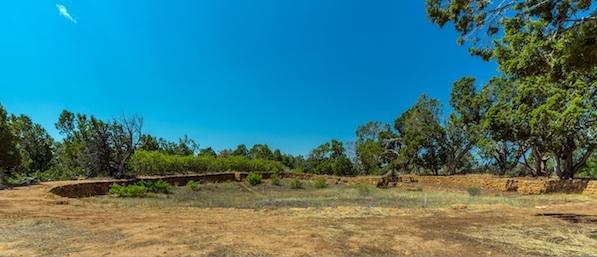
Mummy Lake at Mesa Verde./Rebecca Latson.
Was "Mummy Lake," now known as Far View Reservoir, really an ancient Anasazi reservoir? Not according to new research, which claims the 12-foot deep circular brick structure at Mesa Verde National Park instead was created for ceremonial purposes.
For nearly a century the structure was thought to have been built more than 1,000 years ago to hold water for watering Anasazi gardens. But research presented in the Journal of Archaeological Science says that wasn't the intent at all. Rather, the archaeologists believe "that it is an unroofed ceremonial structure, and that it serves as an essential component of a Chacoan ritual landscape."
"A wide constructed avenue articulates Mummy Lake with Far View House and Pipe Shrine House," adds Dr. Larry Benson in an abstract to the article that appeared in the Journal's March 6 edition. "The avenue continues southward for approximately 6 km, where it apparently divides, connecting with Spruce Tree House and Sun Temple/Cliff Palace. The avenue has previously been interpreted as an irrigation ditch fed by water impounded at Mummy Lake; however, it conforms in every respect to alignments described as Chacoan roads."
In an interview with Western Digs, Dispatches from the Ancient American West, Dr. Benson added that 1,000 years ago there wasn't a way to capture enough rain to fill the structure.
'What we found out was that the area that could drain into Mummy Lake wasn't any larger than the area of the Mummy Lake feature,' the retired archaeologist said. 'Therefore, there was not much water that could be provided to Mummy Lake during a normal water year.
'If you look at how much water you could ever put into the depression, it gets no more than several inches in the wettest year in history,' he added, 'and that would've been evaporated out by July or so. During an average year, the water doesn't even stay there as late as June."

 Support Essential Coverage of Essential Places
Support Essential Coverage of Essential Places







Comments
Having visited this site on several occasions over the years I always found it diffcult to view this structure as a lake or reservoir for the same reasons mentioned in this article. This site more resembles an acknowledged Hohokam ballcourt which can be seen in central Arizona than a poorly designed reservoir which would have captured minimal water and would have been the only of its kind known. Both aites seen to share similar construction guidelines and parameters although it is possible that neither is an actual ballcourt I would bet that the function as designed was the same or similar..
In 1998 I was peripherally involved with a team from "Wright Paleontological Institute" set on determining whether this feature served as a reservoir. It seemed to me at the time that, given the inconvenience of other water sources, the Puebloans obviously would take maximum advantage of any pooled water at Mummy Lake ... but it also seemed obvious the contributing drainage area along with local climate would make Mummy Lake a poor project for this purpose. WPI researchers -- primarily eager consulting civil engineers -- developed the thesis that that was the lake's purpose, I think mainly driven by their wishful thinking. Old Puebloan pathways apparently morphed into "feeder canals" in the mind's eye of these water engineers. I'm pleased this 2014 USGS study provided a more sober analysis of the actual function of this site.